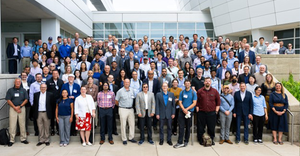Recycling C&D in the Flight for Landfill Space
November 1, 1998
William Turley
Each year, construction and demolition (C&D) debris contributes a crushing blow to the solid waste industry's efforts to reduce the amount of waste being landfilled.
An estimated 200 million tons of C&D debris is generated annually, comprising at least one-third of the U.S. waste stream, according to the Construction Materials Recycling Association, Lisle, Ill.
Now, solid waste managers and industry leaders - from the local to federal level - are employing a diversion cocktail of source reduction, reuse and recycling to keep this cumbersome waste out of the nation's landfills.
For example, at Modern City, N.Y.-based Modern Recycling, employees pulverize C&D debris into profit, processing the incoming material with a large, horizontal-shaft impact crusher, inclined screen, magnets and air classifiers. The fines that are generated by the crushing process can be used as an alternative daily landfill cover (ADC) due to their low organics count.
In addition, the company processes waste aggregate from concrete, blocks and brick into a material that is used for temporary roads around the landfill. "It just makes no sense to put C&D material into a landfill," says Brent Minet, project operations manager.
Occasionally, the company sends processed wood to burn plants elsewhere in New York state, "but it has to be exceptionally clean wood, with no contaminants, such as lead-based paint or aggregate," Minet says.
Recycling C&D materials can make a lot of economic sense to landfill owners, even if the final product is only an ADC. One company, Bethesda, Md.-based Recovermat Technologies, has developed what it says is a patented method to shred C&D materials at the landfill to create an ADC, as well as a material geared for erosion control and for temporary roads as well.
Save Our Space No matter what product is created, recycling C&D on-site at landfills could be a matter of survival, says Robert Brickner, senior vice president of GBB Inc., a consulting firm based in Fairfax, Va. "If a C&D landfill is running out of space, it has a couple of choices: It can fight for a new permit, cut the flow to the site by half to conserve space [which also cuts revenues by half] or close the site," he says. "But recycling can extend the site's life."
When it comes to recycling C&D waste, Brickner notes two attitudes held by landfill operators: Some wonder why they should take on the added expense of recycling when they have been landfilling for years and making money; others seize the opportunity and use recycling to make more money, conserve landfill space and do something positive for the environment.
Don Clark, regional manager for Mark Dunning Industries, Dothan, Ala., is one operator who believes that space conservation is a major reason to consider recycling C&D debris.
When the company opened its new C&D landfill in Dothan, it immediately installed a large grinder on-site and instructed workers to separate most of the incoming wood and process it into boiler fuel. Metal and clean old corrugated cardboard (OCC) also are separated. The remaining waste is run through the grinder for a 6-to-1 volume reduction before heading for the landfill.
"We don't make any money selling the wood chips; we make it on saving space," Clark says. "I don't think a lot of people in the waste industry know the true value of their [landfill] space and how important saving it is."
This conservation philosophy has reaped tangible benefits for Dunning. By August 1998, the Dothan landfill had been in operation for 18 months, and although a second cell had been excavated and was ready for use, the company still was using the first cell it opened.
"If we hadn't performed recycling and volume reduction, we would have been through that first cell in five months," Clark says.
Since beginning recycling, Clark has witnessed a couple of unexpected benefits as well. For example, the company installed a concrete pad for the haulers to dump the waste on for sorting. The pad has become a big hit with haulers during inclement weather.
"It is quicker and easier for the trucks to dump on the pad rather than go sliding up and down some muddy slope," Clark says. "Also, the tipping area makes the waste stream more controllable. It's a better system than having an employee run up the hill to tell us a hauler has dumped something it shouldn't have."
Recycling also has boosted Dunning's public relations efforts. Government officials, proud of how C&D debris is being recycled in the state, constantly conduct tours through the company's facility. This positive atmosphere enhances the already good relations with the state regulatory boards, says Clark, who notes, "I would rather work with them than against them."
Because Dunning's regular tip fee is competitive - approximately $4 less per ton than what nearby landfills charge - recycling at the landfill virtually guarantees the company a steady flow of raw material. Also, any processing mistakes that Dunning employees make can be buried, as can material that is inappropriate for recycling.
Recycling at a landfill site does not always have to involve heavily mechanized methods. For example, employees at Voyageur Disposal & Processing's two landfills in rural Canyon, Minn., recently began hand-sorting waste for wood and OCC, and began using a magnet with a grapple to collect metals.
"We get a lot of material that can be re-used," says Julie Vidmar, Voyageur's environmental specialist. "Contractors sometimes toss unused shingles or wood into our dumpsters."
Voyageur's employees grind the wood for burn plants and occasionally for mulch, but recycling wood and OCC are break-even propositions at best - certainly not as profitable as metals.
"Nothing is forcing us to recycle, but we see that five or 10 years down the road [recycling at landfill sites] will be as common as consumer recycling," Vidmar says. "That's why we have started sticking our toes in the water now to learn gradually. We want to isolate where the good markets are."
As is the case with recycling any material, knowing and understanding the products' end markets is crucial for an operation's survival.
"Many people entering the business don't do a good enough job in researching the final markets," GBB's Brickner says. "It does not make sense just to build the plant and figure out later what to do with the product. You need to have a pretty good idea of what to do with the product beforehand."
And don't forget about purchasing the proper equipment.
"Get the equipment that will make the product that the end market needs," Brickner says. "You should be tweaking the product to meet the customer need, not generating the products first and then trying to find a market that will fit what you generated.
"For example," he continues, "a burn plant requires a lower level of wood product than does a value-added customer, which might request a specific type of chip."
Get Out Your Wallet Most students of the C&D industry agree that recycling construction materials at a landfill is a trend that should continue. But others, such as Modern Recycling's Minet, wonder how many operations can afford the high initial capital expense of setting up a recycling station at their landfills.
For example, although Voyageur primarily picks out incoming material, it had to purchase equipment to do the job. And Modern Recycling and Mark Dunning Industries have invested at least $1 million in equipment for their more elaborate recycling operations.
However, it's more than just money, Clark says. "Buying the grinder was a huge investment up front," he says. "But we wouldn't have done it if we were just trying to fill up a hole. Recycling allows us to save our space and to pick up customers that want to be associated with a recycling operation. For us, recycling is just part of taking the long-term view."
Recycling may be a long-term, big-ticket project, but Brickner cautions landfill operators should not forget the little things.
"The biggest mistake I see is not understanding the total unit costs of producing recycled C&D materials," Brickner says. "Some operations don't do a detailed analysis of all the marginal economics involved in running a recycling system, whether they include loader costs, total manhours or power. Not all the costs are accounted for, and then the operator wonders how it lost money."
But whatever their reason for recycling C&D, operators should properly plan and execute the process to ensure that it will be a profitable venture in the long-term.
You May Also Like


